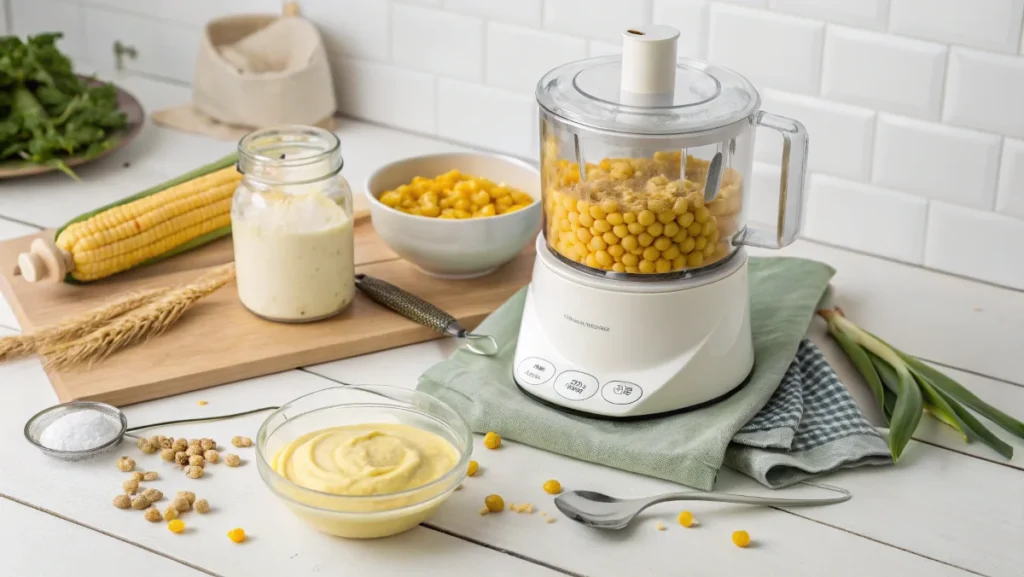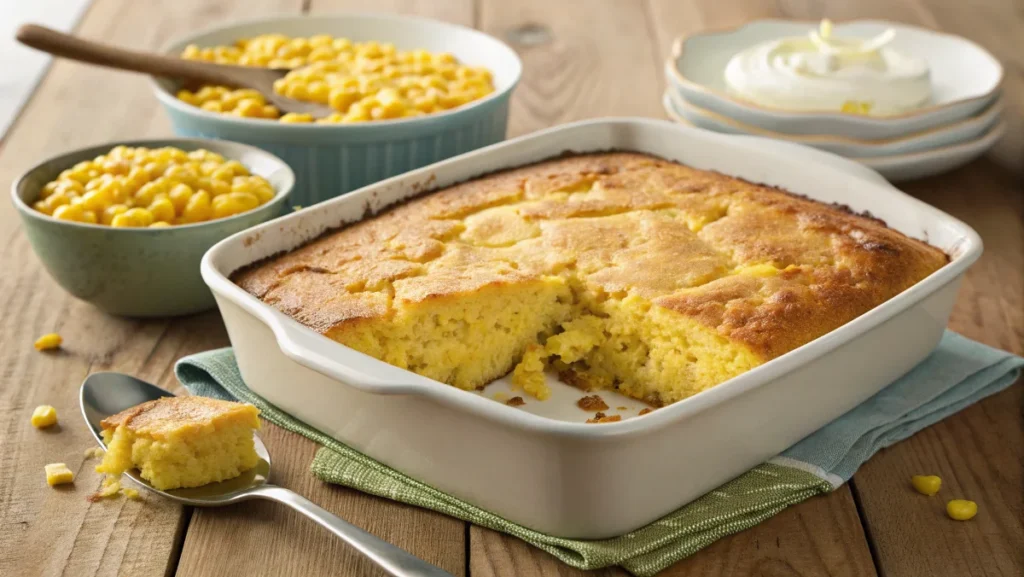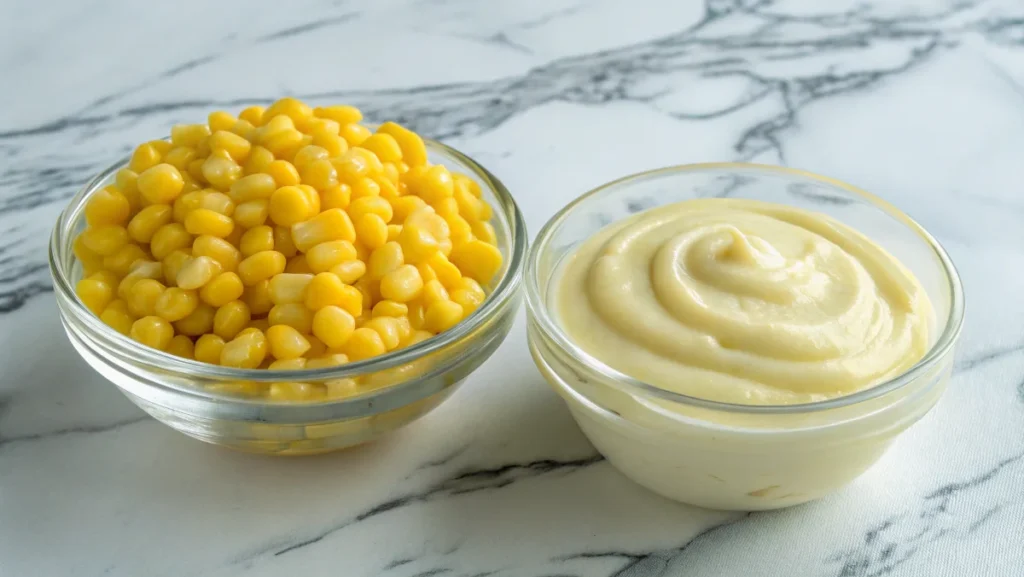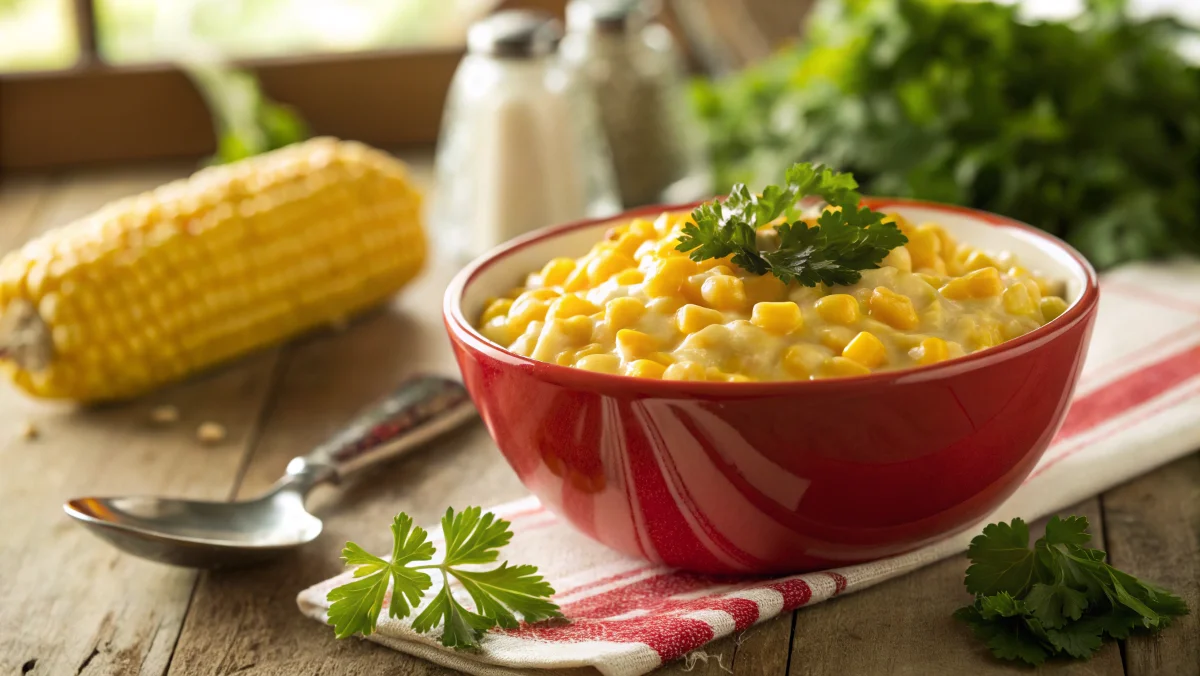If you’ve ever started cooking only to realize you don’t have a crucial ingredient, you’re not alone. One common question in the kitchen is about canned corn vs creamed corn—can one replace the other in recipes? The answer is yes, but it takes a few tweaks to achieve the right texture and flavor. This guide will dive deep into the differences between canned corn vs creamed corn, why you might make the switch, and how to do it effectively. For inspiration on dishes that highlight corn’s versatility, check out Corn Pudding Recipe: The Ultimate Guide to a Perfectly Irresistible Dish, where creamy corn takes center stage in an unforgettable way.

Table of Contents
What Is the Difference Between Canned Corn and Creamed Corn?
What Is Canned Corn?
Canned corn is a pantry staple made from whole corn kernels that are cooked, preserved, and packed in water or brine. The kernels retain their natural shape, firmness, and slightly sweet taste. The texture is crunchy, making it ideal for salads, stir-fries, and side dishes. While convenient and versatile, canned corn lacks the creaminess that some recipes, like cornbread or casseroles, require.
What Is Creamed Corn?
Creamed corn, on the other hand, is a combination of corn kernels and a creamy liquid. Unlike canned corn, part of the corn is pureed or mashed, which creates a thick, velvety texture. Some store-bought versions include added sugar, starch, or dairy for richness and flavor. This makes it a perfect ingredient for recipes where creaminess and a hint of sweetness are essential.
Key Differences in Recipes
The most significant differences between canned corn and creamed corn lie in texture and taste. Canned corn has a firmer bite and isn’t naturally sweet or creamy, whereas creamed corn has a smoother consistency with a sweet undertone. Recipes that rely on creaminess, such as soups or casseroles, may not achieve the same result with plain canned corn unless modified.
Why Would You Substitute Canned Corn for Creamed Corn?
Convenience and Accessibility
Canned corn is often more readily available than creamed corn. It’s also more affordable and has a longer shelf life. When you don’t have creamed corn on hand, canned corn is an excellent alternative with some quick adjustments.
Dietary Adjustments
For those with dietary restrictions, using canned corn as a substitute can offer more control over the ingredients. You can make it dairy-free by using non-dairy milk or create a low-sugar version by skipping the added sweeteners.
Cooking Preferences
Some recipes benefit from the texture of whole canned corn, which adds more bite compared to the smoothness of creamed corn. For example, casseroles or soups with chunky textures may work better with canned corn. Additionally, canned corn allows you to adjust sweetness and creaminess to your liking. If you’re curious about how different corn-based dishes compare, explore What’s the Difference Between Corn Pudding and Corn Casserole? for a deeper dive into their unique textures and flavors.

How to Turn Canned Corn Into Creamed Corn
Transforming canned corn into a suitable replacement for creamed corn is easier than you might think. Here’s a step-by-step guide:
Step 1: Blend a Portion of the Corn
Start by draining the liquid from the canned corn. Use about half the amount of canned corn called for in your recipe and blend it until smooth. A food processor, blender, or even a handheld masher works for this step. The goal is to create a creamy base while leaving some of the corn whole for texture.
Step 2: Add Creaminess
Combine the blended corn with the unblended kernels. To mimic the creamy consistency of creamed corn, stir in a liquid like:
- Heavy cream
- Whole milk
- A dairy-free alternative (e.g., almond milk, coconut milk)
Start with 2–3 tablespoons of liquid and adjust based on your recipe’s requirements.
Step 3: Adjust the Thickness
If your mixture is too runny, add a thickening agent like:
- Cornstarch: Dissolve 1 teaspoon in a small amount of water and mix it into the corn.
- All-purpose flour: Whisk 1 teaspoon of flour into your liquid before adding it to the mixture.
Step 4: Enhance the Flavor
To replicate the slight sweetness of creamed corn, add:
- A pinch of sugar or a small drizzle of honey.
- A dollop of butter for richness.
Taste and adjust the seasoning with salt and pepper to balance the flavors.
With these adjustments, your canned corn will closely resemble creamed corn and work seamlessly in your recipe.

Best Recipes That Use This Substitution
Using canned corn as a substitute for creamed corn opens the door to many delicious recipes. Here are some popular dishes where this swap works perfectly:
Cornbread Recipes
Cornbread often relies on creamed corn for its moist, rich texture. Substituting canned corn allows you to control the sweetness and texture, ensuring your cornbread is fluffy and flavorful.
Casserole Dishes
Casseroles like corn pudding or green bean casserole benefit from the creamy base that creamed corn provides. Using the canned corn substitution adds a hearty bite while maintaining the creamy consistency.
Soups and Stews
Recipes like corn chowder or cream-based soups call for creamed corn to add depth and richness. Blending canned corn achieves a similar result while adding fresh, chunky textures.
Side Dishes
Creamy corn side dishes, often served at barbecues or holiday dinners, can easily incorporate the canned corn substitution. The creaminess balances well with other rich dishes.

Pros and Cons of Using Canned Corn Instead of Creamed Corn
Pros
- Availability: Canned corn is easier to find and store than creamed corn.
- Cost-effective: It’s often less expensive and comes in larger quantities.
- Customizable: You can adjust the creaminess, sweetness, and flavor based on your dietary needs.
- Texture: Adds a chunkier texture to dishes where creamed corn might feel too smooth.
Cons
- Extra Preparation: Transforming canned corn into creamed corn requires blending, mixing, and additional ingredients.
- Flavor Difference: The natural sweetness and creaminess of store-bought creamed corn can be challenging to replicate exactly.
- Time: Making this substitution may add extra time to your cooking process.
When Canned Corn Works Best
This substitution works particularly well in recipes where texture variations are welcome, such as casseroles, soups, and cornbread. However, for recipes where a silky smooth texture is crucial, additional effort may be needed to achieve the desired result. For those interested in exploring versatile staples in different cuisines, take a look at Habichuelas: A Latin American Staple – Benefits, Varieties & Recipes to discover another beloved ingredient with endless possibilities.
Common Mistakes When Using Canned Corn Instead of Creamed Corn
Mistake 1: Not Blending the Corn
One of the biggest errors is using canned corn directly from the can without any modifications. Creamed corn has a creamy consistency, and skipping the blending step can lead to a dish that lacks the smooth texture expected.
Mistake 2: Forgetting to Adjust the Flavor
Canned corn is less sweet than creamed corn, which often contains added sugar. Without enhancing the flavor, your recipe may taste bland. Adding a pinch of sugar or a drizzle of honey ensures the sweetness matches the original.
Mistake 3: Overlooking the Liquid Content
Draining canned corn is essential before blending. If you use the liquid from the can, your mixture might become too watery, affecting the final texture of your dish.
Mistake 4: Skipping Thickening Agents
Creamed corn is naturally thickened with starch or flour. If you substitute canned corn without adding a thickener, the consistency may be too loose, especially in baked goods like cornbread.
Benefits of Making Homemade Creamed Corn with Canned Corn
Customizable Ingredients
One of the greatest advantages of using canned corn as a base for homemade creamed corn is the ability to control the ingredients. You can adjust the amount of sugar, salt, and creaminess based on your preferences or dietary restrictions.
Cost-Effective Option
Canned corn is typically more affordable than store-bought creamed corn. By making your own version, you can save money while still achieving a delicious result.
No Unwanted Additives
Some store-bought creamed corn contains preservatives, high amounts of sugar, or artificial flavors. Making your own substitute ensures you know exactly what’s in your food, which is especially beneficial for those with allergies or sensitivities.
Fresh Flavor and Texture
Homemade creamed corn made with canned corn offers a fresher taste compared to pre-packaged versions. You can also decide how much texture you want by blending more or fewer kernels.
Versatile Usage
Once you’ve created your own creamed corn, it can be used in a variety of dishes, from savory casseroles to sweet cornbread. The process is simple and opens up endless possibilities for customization.
Alternative Substitutes for Creamed Corn
If canned corn isn’t available or doesn’t suit your needs, here are some other substitutes for creamed corn:
Frozen Corn
- How to Use: Thaw frozen corn and blend half the kernels to mimic the creamy texture. Add cream or milk for consistency.
- Benefits: Frozen corn often has a fresher flavor and texture than canned options.
Fresh Corn
- How to Use: Cut kernels off fresh corn cobs and blend a portion of them. Mix with cream, milk, or butter for creaminess.
- Benefits: Fresh corn provides a natural sweetness and is ideal for summer recipes.
Corn and Cream Mixture
- How to Use: Combine cooked corn with heavy cream, butter, and a small amount of cornstarch or flour to thicken the mixture.
- Benefits: This method is perfect for creating a rich, creamy consistency without relying on processed options.
Coconut Milk for Dairy-Free Versions
- How to Use: Blend corn kernels with coconut milk and a touch of sugar for a dairy-free alternative.
- Benefits: Coconut milk adds creaminess while maintaining a subtle sweetness.
Frequently Asked Questions About Substituting Canned Corn
1. Can I Make Cornbread Casserole Without Cream Corn?
Yes, you can make cornbread casserole without creamed corn! A simple substitute is to use canned corn and create a creamy texture yourself. Drain a can of whole kernel corn, blend half of it to form a creamy base, and mix it with the unblended kernels. Add 2–3 tablespoons of heavy cream, milk, or a dairy-free alternative to replicate the texture and flavor of creamed corn. This substitution works well in recipes and allows you to customize sweetness and thickness. For more tips on preparing dishes ahead of time, take a look at Can I Make Habichuelas in Advance? Storing & Reheating Tips to simplify your cooking process.
2. What Is the Difference Between Creamed Corn and Canned Corn?
- Canned Corn: Contains whole kernels packed in water or brine. It has a firm texture and mild sweetness.
- Creamed Corn: Combines whole and partially pureed corn with a creamy liquid, often sweetened and thickened. Its texture is smoother, and it provides added richness to dishes.
Canned corn is more versatile for various recipes, while creamed corn is specifically used to add creaminess and flavor.
3. How Do You Thicken Cream Corn from a Can?
To thicken cream corn from a can:
- Heat it in a saucepan over medium heat.
- Mix 1 teaspoon of cornstarch or flour with a small amount of water to form a slurry.
- Stir the slurry into the cream corn and cook until it thickens.
You can also add heavy cream or grated cheese for extra richness while thickening.
4. What Is the Purpose of Creamed Corn?
Creamed corn adds flavor, moisture, and creaminess to dishes. Its smooth texture and slightly sweet taste make it ideal for recipes like cornbread, casseroles, soups, and stews. It enhances the overall consistency and provides a comforting, rich element to meals.
Conclusion: Making the Most of Canned Corn vs Creamed Corn in Recipes
Substituting canned corn for creamed corn is a simple and effective solution when you’re in a pinch or looking to customize your recipes. With a little blending, the addition of cream or milk, and some seasoning adjustments, you can achieve a texture and flavor close to store-bought creamed corn.
This substitution is versatile and works well in a wide range of dishes, from cornbread to casseroles, soups, and side dishes. It’s also a cost-effective option, giving you complete control over the ingredients and flavors. Whether you prefer a sweeter taste or need a dairy-free alternative, canned corn provides a flexible base for making your own creamed corn at home.
The next time you’re in the kitchen and find yourself without creamed corn, remember these tips and techniques to create a delicious substitute. If you’re interested in exploring how other versatile staples are prepared, check out How are Habichuelas Prepared? A Complete Guide to Cooking and Enjoying Beans for inspiration from Latin American cuisine.

